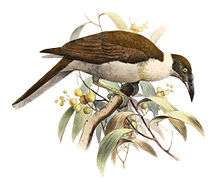Manus friarbird
The Manus friarbird or white-naped friarbird (Philemon albitorques), also known as the chauka (souka in the local language, Lele[2]) is a species of bird in the Honeyeater family, or Meliphagidae.[3] It is endemic to the Manus Province[4] of Papua New Guinea.
| Manus friarbird | |
|---|---|
 | |
| Scientific classification | |
| Kingdom: | Animalia |
| Phylum: | Chordata |
| Class: | Aves |
| Order: | Passeriformes |
| Family: | Meliphagidae |
| Genus: | Philemon |
| Species: | P. albitorques |
| Binomial name | |
| Philemon albitorques Sclater, 1877 | |
Its natural habitat is subtropical or tropical moist lowland forests. It is also commonly found around human habitation, and possibly favoured by human settlement and the more open habitats created by people in many coastal areas.[3]
The chauka is well-known to locals on Manus Island, who speak of its ability to tell the time. It could be the most iconic honeyeater within its range in the world, as well as the loudest.[3] Numerous stories and myths about the many abilities and duties of the chauka include alerting people to snakes in trees and informing people about a recent birth in the community.[2].
Its significance to Manus is also reflected in its representation on the Manus provincial flag. Designer of the Manus Province flag, Luke Bulei, explained his reasons for its design in 1977: the chauka is only found in the Manus province; it heralds dawn and signals sunset; it often warns us of dangers; and lastly, it informs us of the success or otherwise of a forthcoming hunting trip. He added that NBC Radio Station had changed its name to Maus Bilong Chauka (Voice of the Chauka) several years before. [4]
The bird was used symbolically in the film Chauka, Please Tell Us the Time, made from within the Manus Island detention centre by refugee Behrouz Boochani and filmmaker Arash Kamali Sarvestani in 2016.[5]
Further reading
- Fitzsimons, James (September 2014). "Notes on the distribution and breeding of the Manus Friarbird 'Philemon albitorques' and other birds of small islands of the Admiralties group, Papua New Guinea". 31 (3). Australian Field Ornithology: 159-163. ISSN 1448-0107. Cite journal requires
|journal=(help) (Full PDF AU$4.00)
References
- BirdLife International (2012). "Philemon albitorques". IUCN Red List of Threatened Species. 2012. Retrieved 16 July 2012.CS1 maint: ref=harv (link)
- Boetgger, Juliane (March 2015). Topics in the grammar of Lele: A language of Manus Island, Papua New Guinea (PDF) (PhD). Appendix V. James Cook University. College of Arts, Society and Education. p. LXXIII.
- Fitzsimons, James (19 June 2013). "The Charismatic and Elusive Birds of Manus Island". Retrieved 10 February 2019.
- "Manus (Papua New Guinea)". Flags of the world. 2009.
- Zable, Arnold (17 October 2017). "From Manus to London: how two strangers made a landmark movie together". Sydney Morning Herald. Archived from the original on 10 February 2019. Retrieved 10 February 2019.
